Lowerniel Drakan
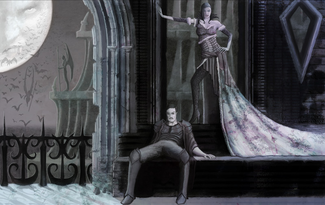
Lord Lowerniel Vergidiyad Drakan, more often referred to simply as Lord Drakan, is the vampyric overlord and conqueror of the majority of the Morytania region. Drakan has adopted many titles to assert his authority, amongst them Prince of the Blood and Regent of the Sanguine Fields.<ref>http://services.runescape.com/m=rswiki/en/Postbag_40 "Postbag From the Hedge 40," Letter to Vanstrom Klause</ref> He has also been referred to as His-Dark-Self and The Dark Lord. Drakan has, since the Second Age, been a force of strong opposition to the majority of Gielinor's racial and religious factions, allying himself with powerful entities including Zaros and Zamorak.
Lord Drakan's age is unknown, but the first accounts of his existence date back to the early Second Age, making him at least 8,000 years old. The enigmatic nature of the vampyric race leaves his origins in question, but it is likely that he either is foreign to Gielinor and arrived from another world at some point shortly after Guthix's descent into hibernation, or was created during his hibernation using magics from another world.
After arriving, Drakan allied himself with the deity Zaros, who owned a large amount of land encompassing the majority of the eastern Gielinorian mainland. Although he likely served Zaros for more than a thousand years, Drakan aided the Mahjarrat Zamorak in his assassination, leading to Zaros's banishment and Zamorak's ascension to godhood. In exchange for his assistance, Zamorak permitted Drakan to invade the eastern nation of Hallowland during the Third Age.
Drakan conquered the Hallowland and renamed the region Morytania, transforming Hallowvale into a blood-farming ghetto. Drakan's reign has been marred by violence, including, amongst countless others, the Fall of Hallowvale, the Misthalin - Morytania War, the Morytania Campaign,<ref>http://services.runescape.com/m=rswiki/en/The_Fall_of_Six "The Fall of Six", RuneScape Lores and Histories.</ref> the War of 164<ref>Church, Tom S. Betrayal at Falador, (78-79). Babel Interactive Ltd., 2008.*</ref>, and the Sanguinesti Liberation War. Today he continues to struggle with Saradominists both in neighbouring regions and within Morytania's own borders, most notable of which are The Myreque. He has developed a particularly strong vendetta against Varrock, the capital of Misthalin. Despite his immense importance to both ancient and modern history, Drakan has managed to remain unseen by the public eye during much of his reign, and has thus far never been seen in-game.
History
Origins

Details regarding Lord Drakan's origins and time of birth are virtually non-existent. The earliest accounts of his existence date back to the late Second Age, but the vampyric race's enigmatic nature <ref>http://services.runescape.com/m=rswiki/en/The_Races_of_RuneScape#Vampyres "The Races of RuneScape," RuneScape Knowledge Base</ref> calls into question when and where he was born.
During the First Age, the deity Guthix shaped Gielinor using both his own divine powers and that of the Stone of Jas. For four thousand years Guthix moulded what is now known as Gielinor, expending such energy that he was forced to descend into a 6,000 year slumber, beginning what would come to be known as the Second Age. With Guthix asleep, many races and deities were able to enter Gielinor without being challenged. The vampyric race's origins itself remain uncertain.
Drakan is believed to have been amongst the first vampyres in Gielinor, arriving in the early Second Age from their realm of Vampyrium. Lowerniel and his siblings are likely amongst the few remaining examples of natural vampyres, as opposed to converted vampyres. Vanstrom Klause claims that the vampyre race is older than the Mahjarrat, suggesting that Drakan's birth likely pre-dates the Second Age. However, if his birth is placed at the beginning of the Second Age, Drakan is over 8,000 years old. If he came to Gielinor matured, like Mahjarrat such as Azzanadra, it is possible that he is much older.
Various other theories and legends regarding Drakan's origins exist, although these are now believed to be largely inaccurate myths. One such legend states that Drakan and the rest of the Morytanian populace surfaced from a massive underground city beneath the Icyene's Castle in Hallowvale. Another claims that, far beneath Morytania, an endlessly burning inferno spawned Drakan and his hordes. They then supposedly emerged from a tunnel network and invaded the Hallowland. The fact that he descended from Vampyrium, however, debunks all theories.
Second Age
Allegiance to Zaros
Upon his arrival or creation in Gielinor, Lord Drakan was amongst a number of racial factions to ally themselves with Zaros, or the Empty Lord, a powerful deity who owned an already progressively growing empire that would eventually encompass much of what is now Misthalin, Asgarnia, Morytania, and the Wilderness. In modern times, nearly all information pertaining to Zaros has been concealed by other religious groups;<ref>http://services.runescape.com/m=rswiki/en/God_Letters_Issue_14 "God Letters Issue 14 - The Return of Saradomin," Miscellaneous Answers.</ref><ref>http://services.runescape.com/m=rswiki/en/God_Letters_Issue_27 "God Letters Issue 27 - Saradomin Enlightens," Questions from Andrey111</ref> this, coupled with the immense amount of time since his reign, makes information regarding Drakan during this time very rare. By all accounts, Drakan rapidly became one of Zaros's most crucial generals. The majority of Zaros's generals were Mahjarrat, leaving Drakan a minority amongst the military elite. This fact was not overlooked by his fellow military leaders, including humans, demons, and dragon riders.
With Drakan's assistance, Zaros's empire would continue to expand even until its very downfall. The area that is now the Wilderness was the most thoroughly controlled of Zaros's regions. The area's extremely arable soil, thick vegetation, and stable climate made it an ideal place to place the majority of his empire, leading Zaros to lead a brutal military campaign against the various tribes of various races that had migrated to the region during the First Age. Drakan himself is believed to have led many of these campaigns, suggesting that he was, after proving his ability, the leader of the entire vampyric race, beneath only Zaros. An early incarnation of House Drakan would have been established during this time, as Drakan has by all accounts believed in his family's supremacy since the beginning of his time in Gielinor. During this time, countless cities and fortresses were established, some of the largest of which included Dareeyak, Carrallangar, Annakarl, and Ghorrock.
The military genius of Drakan and others eventually gave Zaros the talent he needed to push farther south, where he claimed what is now Asgarnia, Misthalin, northern Morytania, and possibly even the northernmost fringes of the Kharidian Desert. Massive city-forts such as Senntisten, Paddewwa, Kharyrll, and Lassar were established in ideal locations, Drakan responsible at least partially for many of them. The civilisations and trade routes of the First and early Second Ages were thrown into upheaval by Drakan's actions. The Myriad civilisation in southern Misthalin is believed to have fallen during this time, and trade along the Eastern Sea between the Hallowed Lands, the Menaphite civilisation, the Eastern Lands, and central-mainland tribes became more difficult and in some cases impossible. By the end of Zaros's reign, nearly half of the Gielinorian mainland was controlled by him through his generals, Drakan amongst them. Other deities and races made no progress in stopping him.
Assassination Plot
Despite Drakan's long service and immense contributions to the Zarosian empire, it has been suggested that he was never completely dedicated to his lord's cause. Descriptions of life under Zaros's rule have been mixed; while legends claim Zaros possessed extremely loyal followers, more personal accounts from generals such as Viggora describe his rule as one of immense suffering and suppression. Drakan, like most of Zaros's generals, sought mainly to further his own power through service to him. If ever Drakan was suspected of treachery, his position of power would easily allow him to blame others.
Near the end of the Second Age, the then-Mahjarrat general Zamorak silently amassed the support of a number of Zaros's most powerful followers; one of few organised attempts to overthrow him. Drakan was amongst a handful of generals to ally himself with Zamorak in the hope that Zaros could be removed from power and his nation divided. Each swore fealty to him, promising to follow him as their master. However, despite the sizable following Zamorak managed to gather, there existed no apparent way to overthrow Zaros, as his immortality made him impossible to kill.
It was only when the Saradominist mage Dhalak received the Staff of Armadyl from his apprentice Lennissa that a possibility emerged. Dhalak, despite his devout worship of Saradomin, felt that if Zaros could be removed from power, it might be possible to defeat Zamorak's followers afterwards. Dhalak cast a spell of concealment upon the artefact and allowed it to fall into Zamorak's hands, giving him the tool necessary to defeat a god in combat. Because there was always intense suspicion amongst those close to Zaros, the Staff made its way into their hands without drawing attention.
Zamorak, now in possession of Armadyl's god-weapon, formulated a plan to attack Zaros in his fortress alongside Drakan, Thammaron, Hazeel, Zemouregal, Viggora, and Lucien. The generals entered Zaros's fortress (the location of which has never been revealed) on the pretence of discussing war plans against the Saradominists and other religious factions that continued to engage in skirmishes along the nation's borders. Upon entering Zaros's throne room, Drakan and the rest engaged Zaros's bodyguards in combat. Zaros retaliated, but the group narrowly escaped his blows, giving Zamorak time to circle the god and impale him with the staff.
Drakan managed to hold his ground for the remainder of the battle, which ended when Zamorak was impaled upon the same staff and Zaros's powers transferred to him. Zaros was banished from Gielinor, but only after he laid a curse upon those responsible for his defeat. Drakan was amongst the generals to suffer this, but the immense amount of magic running through his blood either made him immune or continues to delay its effects until this day. The group paid witness as the majority of Gielinor's active deities appeared in the room and banished Zamorak from Gielinor for moving against one of their race, although they were his enemies. The generals were successful in ending Zaros's empire, but Zamorak's plans were yet to end.
In Hiding
With Zaros banished to an unknown plane of existence, his empire immediately began to crumble. Although some of his cities such as Senntisten would continue to survive for years after his defeat, Zamorak had essentially been successful. However, with him banished, his closest followers were forced into hiding as Zarosian loyalists and various other groups sought their death. His hiding was made somewhat easier by the fact that most of Zaros's followers shifted their allegiance shortly after his disappearance in order to survive.<ref>http://services.runescape.com/m=rswiki/en/Postbag_27 "Postbag from the Hedge 27", letter from Eblis.</ref>
The need to hide was short-lived, however. Zamorak returned to Gielinor only several years after his banishment, having fully absorbed and mastered the powers he had stolen from his former master. Drakan immediately came to his side, as did many of his original allies and Zaros's former followers, now ready to resume their takeover of Gielinor. This, amongst many factors, would mark the beginning of the four-thousand year-long God Wars.
Third Age
The Fall of Hallowvale
Lord Drakan entered the Third Age as a mostly independent military lord. He conceivably assisted Zamorak in his early battles against not only those Zarosians still loyal to their god, but also against the countless other religious and racial factions that now sought to claim land without invoking a response from the Empty Lord. However, like most of Zamorak's conspirators, Drakan had been promised land in exchange for his services. Like Thammaron, who opted to later invade the Uzer metropolis of the Kharidian Desert, Drakan was promised an area already developed by an opposing civilisation: the Hallowland.
The Hallowland was amongst very few true civilisations to survive into the early Third Age. The region's temperate climate, arable soil, and ideal location along the coast of the Eastern Sea made it one of the most prosperous civilisations in Gielinorian History. The Saradominist Icyene, who had come from the Eastern Lands during the Second Age, had lived in harmony with the area's human population since their arrival, establishing a mostly agricultural utopia from Hallowvale northwards toward the Zarosian outpost of Kharyrll. Drakan saw the region as an ideal place to establish his empire, although for what reasons remains a mystery. Drakan displays no interest in trade, agriculture, or any of the area's other inherent advantages, leaving his exact intentions unsolved.

Drakan entered the Hallowland through Silvarea, with an army of vampyres and other magically-infused races behind him. Although some members of these races remained behind to serve Zamorak, Drakan took with him a massive number of devoted followers. Details regarding the Fall of Hallowvale remain scarce. Kharyrll, the easternmost settlement of Zaros's former empire, was likely the first settlement to fall, although it has also been suggested in sources of debatable canonicity that Kharyrll may already have fallen to werewolves and re-named Cave Canem. If this is true, than Drakan's conquering of Cave Canem earned him a significant following of werewolves. Queen Efaritay and King Ascertes, the rulers of Hallowvale at the time, fought back with immense military power, their Icyene warriors were more than a match for Drakan's forces. The Icyenes' intricately-crafted weaponry far surpassed that of Drakan's soldiers, and their gift of flight made them powerful adversaries in virtually any situation. Regardless, while the northern, agricultural portions of the Hallowland fell with relative ease, the more established cities and fortresses to the south had been established more than 800 years before and were well-equipped to handle prolonged siege. The two forces found themselves in a bloody stalemate, and so Drakan secretly oversaw the kidnapping of King Ascertes, whom he threatened with a painful death should Efaritay continue the war. Efaritay was forced to surrender herself to Drakan and was imprisoned by Drakan regardless of the terms of the exchange. Both she and Ascertes were presumably killed following their capture, leaving the people of the Hallowland leaderless in the final days of the war.
Drakan pushed his way into Hallowvale with relative ease, where he toppled what remained of the nation's leaders and military. The Icyene were, like the Dragonkin and various other races, native to the Eastern Lands and thus their populace on the Gielinorian mainland was relatively small. The mass-slaughter that took place throughout the Hallowlands following the capture of Ascertes and Efaritay left the race decimated. While some had gone beyond the River Salve to assist the Saradominists in the God Wars, the majority of the race was present in Hallowland at the time and suffered heavy casualties.
Establishing Morytania
Upon capturing Hallowvale, Drakan immediately appointed himself dictator of the region, quickly establishing a solid totalitarian government consisting of members of House Drakan. Drakan oversaw the first of many historical censorships, renaming the Hallowland Morytania, Hallowvale Meiyerditch, and the south-eastern portions of the nation the Sanguinesti Region. Hallowvale's castle, formerly the home of Ascertes and Efaritay, was renamed Castle Drakan and made the home of much of the vampyric nobility. Much of the region's land was divided into smaller territories granted to nobility such as Malak and Dessous, although most of this land is no longer used. Some structures, such as the subterranean ruins in south-western Morytania, may have been commissioned by Drakan during this time.
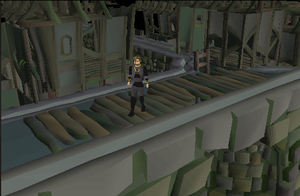
Drakan, through unknown magical means, brought a permanent veil of storm clouds over much of the region, permanently blocking out the sun and bringing in rains so heavy that the once forested land gradually became a largely impassable swamp. In some areas, such as west of what is now Port Phasmatys, flood waters rose to such heights that passage was virtually impossible.<ref>http://news.runescape.com/newsitem.ws?id=361 "Ghosts Ahoy and Slayer Update," RuneScape News Article.</ref> The centre of Morytania, now known as Mort Myre Swamp, became uninhabitable, haunted by starved ghasts seeking nourishment. The flora and fauna native to the Hallowland were forced to undergo drastic evolutionary mutations to survive; some, such as Hirudinea Acidia and Achatina Acidia Giganteus, have grown to sizes ranging from several to hundreds of times their previous size that may be related to pollutants in the area's water. Some species, such as the rare Nail Beasts native to Mort Myre Swamp, possess no discernible origin. The thick fog that now covers Morytania is thick enough to filter the light in eastern Misthalin during sunrise.<ref>http://services.runescape.com/m=rswiki/en/Eulogy_for_a_Forgotten_Hero "Eulogy for a Forgotten Hero," RuneScape Lores and Histories</ref> How exactly Drakan accomplished such a thorough re-shaping of the region's climate remains a mystery, but it is possible that he did it with outside help, possibly from Zamorak himself.
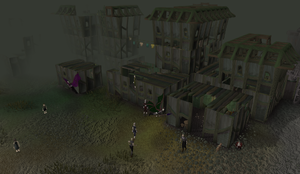
The native humans and Icyene that survived Drakan's invasion were quickly suppressed. In order to maintain control, Drakan established the Vyrewatch, a secret police force whose mind-reading abilities mean they are immune to conventional weaponry. The Vyrewatch appears to be made largely of vampyres converted from other races; their anatomy is extremely similar to the Icyene and it may be that many of them were forced to undergo transformation. The Icyene were either converted or destroyed with such rapidity that their population simply ceased to exist in Morytania, although some would survive beyond the River Salve until the end of the God Wars<ref>http://services.runescape.com/m=rswiki/en/Postbag_39 "Postbag from the Hedge 39," From the Pen of Reldo</ref> and others still lived in the Eastern Lands. Hallowvale, having been largely razed to the ground in Drakan's invasion, was rebuilt as a maze-like blood-farming ghetto with no evident way out. All previously existing entrances were sealed, leaving the city virtually inescapable. The werewolves, who had allied themselves with Drakan during the invasion, were subjugated by their master to living beyond the Sanguinesti Region's borders, living in a sometimes feral state in settlements throughout Morytania. As time progressed, vampyres, werewolves, and other minions of Drakan established additional settlements beyond Sanguinesti. However, today few still remain.
Hallowvale's rapid fall and transformation all occurred without attracting widespread attention in the rest of the world. Beyond the River Salve, the main body of the God Wars had quickly escalated to such a point that virtually every race in Gielinor had become involved. Zamorak, although still an ally of Drakan, had effectively ceased being his master and turned his attention to dealing with deities such as Saradomin, Bandos, Armadyl, and countless others. Drakan's legacy and involvement with Zaros gradually was forgotten by the majority of the Gielinorian populace until virtually no record of his prior actions existed. This, coupled with Morytania's isolated location, caused Drakan to evolve into something of a legend, around which many, mostly false stories circulated. Although his interaction with entities beyond Morytania was limited for centuries to come, doubt of Drakan's existence never is known to have surfaced.
Bloodfarming
As Drakan solidified his control over Morytania, the living conditions of humans under his rule continued to deteriorate. Survival outside of Sanguinesti itself became virtually impossible; the hostile elements of the swamplands and aggressive followers of Drakan gradually eliminated any seeking to escape his control. Hallowvale's re-construction allowed Drakan to manage the city's inhabitants with unprecedented ease.<ref>http://services.runescape.com/m=rswiki/en/Meiyerditch "Meiyerditch (Members)," RuneScape Knowledge Base</ref> The Vyrewatch patrolling the city were capable of flight, and as such needed no pathways, entrances, or ground-level transport to mobilise. Those thousands of humans on the ground, however, found themselves in a high-rise ghetto where structures were deliberately built to make movement nearly impossible. The ghetto itself was likely built by those humans forced to inhabit it, as slave labour became Drakan's first use for them.
Prior to conquering Hallowvale, the vampyric race was forced to survive by hunting and consuming the blood of their prey. Drakan, now presiding over the majority of Morytania's human population, saw an opportunity to eliminate the need for hunting, which had become increasingly difficult as a result of Morytania's thinning animal population. Drakan invented bloodfarming, a method by which his race could obtain nourishment continuously and easily. This systematic method of taxation continues to exist today.
Meiyerditch was divided into six sectors, each roughly square and making up a sixth of a grid-like pattern that covered the whole of the city. Each sector was divided from the other through barricades and strategic construction, although more physically able residents have managed to cross sector borders with relative ease. The populace of each section of the city was forced to give blood tithes as a form of tax. To control the amount of deaths in victims, Drakan created a system in which the sectors are tithed in rotational order, allowing residents to replenish themselves enough for the next payment. The means by which these tithes are extracted have varied over time from simply making incisions on the victim's body and collecting the blood in containers to more experimental methods that the vampyres have studied but never perfected. The Vyrewatch were and are primarily responsible for farming the ghetto's citizens, and are permitted to take tithes from residents for personal sustenance at any time.
The effects of bloodfarming on the residents of Meiyerditch immediately proved disastrous. Although extremely small youth seem to be exempt from tithing, even young children are forced to pay blood to the Vyrewatch. The majority of the city's residents developed Anemia, leaving the majority of the populace perpetually fatigued, weak, and ill. Diseases developed amongst adults were often inherited by their children, allowing for the spread and mutation of many sicknesses. Drakan, considering humanity no more advanced than cattle, paid little attention to living conditions within Meiyerditch, allowing the city's water supply to become contaminated with toxins similar to those in Mort Myre. Food, clothing, and suitable shelter have become increasingly rare, and thousands have died within the ghetto's wall from violence, the effects of blood tithing, and the elements.
Expansion
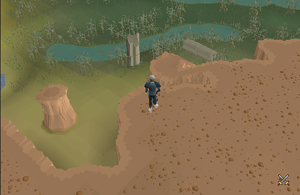
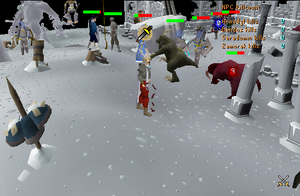
As the Third Age progressed, Drakan became increasingly hostile to those outside of Morytania. Seeking to stretch his territory further west, Drakan saw the establishment of several settlements in what is now north-eastern Misthalin. The violence that engulfed the region, however, meant that no settlement survived long, and that truly controlling the area was virtually impossible. Stories of this time are few, although the werewolves that now inhabit Canifis maintain that they survived beyond the Salve for an extended period of time. What remained of the former Zarosian capital, Senntisten, was constantly shifting hands between many forces, the most prominent of which were the Saradominsts and Zamorakians. Whether Drakan ever became involved with Zamorak's efforts to control the city remains unknown. Ultimately, though, Drakan's efforts to expand west were not successful during the God Wars. He would re-assert his claim on the region later, during the Fourth Age.
Drakan is known to have become actively involved in the Kharidian Desert Campaign from the Years 3,000 to 4,000. The northern Kharidian Desert, formerly a cultural utopia, had managed to evade most of the God Wars' violence for most of the Third Age, although the Zarosian bandits that had been forced into the region during the early Third Age did pose a threat. During the late God Wars, however, Zamorakian, Saradominst, and Menaphite forces sought to control the desert's strategic position. Drakan took advantage of this, sending his forces down the River Salve and through the Eastern Sea, apparently hoping to extend Morytania into the Kharid.
The violence that afflicted the region as a result was amongst the most intense of the God Wars. The peaceful tribes that had once dotted the area were slaughtered carelessly, forcing refugees such as Nardarine to flee to the far south and establish cities such as Nardah and Menaphos. Drakan's joint ventures with Zamorak and independent campaign in the area were apparently somewhat successful. Drakan's presence saw the fall of Uzer at the hands Drakan's former fellow-conspirator Thammaron and the destruction of Ullek by Balfrug Kreeyath, whose success would earn him work under K'ril Tsutsaroth. However, the extent to which Drakan was involved in the area's major conflicts remains a mystery, and ultimately the expansion into the Kharid had crumbled by the early Fourth Age.
Near the end of the God Wars, a garrison of Saradominist loyalists established an outpost on Dragontooth Island off the coast of eastern Morytania, roughly in the vicinity of Braindeath Island.<ref>http://services.runescape.com/m=rswiki/en/Postbag_25 "Postbag from the Hedge 25," RuneScape Website</ref> The military outpost was a threat to Morytania's borders and was the closest permanent non-Morytanian settlement outside the region. It was only at the end of the God Wars or soon after that the entire garrison was completely wiped out, presumably under Drakan's orders.
Drakan seems to have remained somewhat involved beyond the Salve even until the end of the God Wars, judging by the races present during the battle for the Godsword, but even those campaigns did not see any true expansion. The effects of the conflict upon the Menaphite nation, though, were such as that the civilisation never fully recovered. The subtle schism between Scabaras and the rest of the Pantheon had begun to widen, and Amascut's destructive tendencies would only grow.
The Morytania Campaign
In the late Third Age, roughly coinciding with the Kharidian Desert Campaign, Drakan witnessed a large invasion on the Morytanian homefront. The Morytania Campaign was the first organised attempt by Saradominst forces outside Morytania to remove Lord Drakan from power, although many more would follow in later ages. Exact details regarding the campaign are few, but a rough overview is given in both The Fall of Six now kept in Varrock Palace Library and the Legend of the Brothers owned by the "Strange Old Man" near the modern day Barrows site.
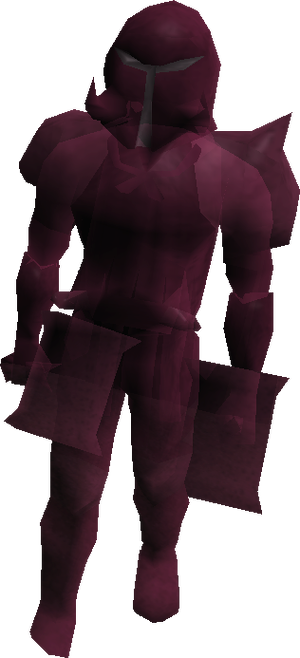
Although the campaign was led by Saradominist forces from various small townships in the region that is now Misthalin, the invasion was in fact orchestrated by an independent and then-unidentified entity. The entity is believed by many to be Sliske, a Zarosian Mahjarrat who's actions are similar to those described in the Fall of Six. According to the story, the entity found six warrior-farmers in a small town, all of whom desired to gain further glory in the God Wars. The stranger gave each a set of powerful armour and urged them to invade Morytania, from which Drakan was now invading outside regions.
The brothers, known as Dharok, Karil, Verac, Ahrim, Torag, and Guthan, gathered a powerful army and led a military campaign into Morytania across the River Salve, presumably through Silvarea. Drakan responded by sending wave upon wave of his forces at the invaders for over a year, resulting in many casualties in both armies. However, the armour the commanders wielded, coupled with their natural ability, was strong enough to make the brothers nearly invincible. Upon nearing the walls of the Sanguinesti Region, the stranger confronted the brothers, telling them that they were doomed to die and serve him in death. The campaign pushed on only briefly after this confrontation, the Brothers met by the largest of Drakan's counter-attacks. Eventually they were slain, their followers constructing an elaborate tomb near Meiyerditch. Drakan saw that those survivors were mocked and abused for the six days they built the burial site before allowing them to leave Morytania and spread word of his strength.
The stranger returned to the burial site later, casting a curse upon the corpses of the Brothers, binding their souls to his will. The Fall of Six maintains that the stranger intends to use them upon the return of his god to first destroy Drakan and then lead armies and overthrow Zamorak.
When the God Wars ended, Guthix established a set of Edicts that stated that, should a second God War begin, Gielinor itself will be destroyed to prevent such violence. Drakan was forced to withdraw the whole of his forces back to Morytania to prevent retaliation by Guthix, although after the god's departure he began to turn towards Misthalin once more.
Fourth Age
The Misthalin - Morytania War
For the first 1,000 years of the Fourth Age, Drakan's rule of Morytania was relatively straightforward. The region's people continued to fall deeper and deeper under Drakan's control, and Drakan's efforts to expand his territory came to a relative standstill. Bloodfarming continued to grow in efficiency and all opposition was defeated easily. It was not until approximately the Year 1100 that Drakan again set his sights on Misthalin, from which he had been forced to retreat at the end of the God Wars.
Drakan's forced retreat into Morytania had allowed Misthalin to grow without his interference. For a brief time in the early Fourth Age, small parts of the nation were held by elven settlers from Tirannwn under the protection of King Baxtorian and the Cadarn Clan, although most settled in Kandarin. Saranthium, which had replaced Senntisten during the late Third Age, flourished for several centuries but ultimately fell during the early Fourth. It was not until Avarrocka (now known as Varrock) was established in 700 that a more enduring nation was formed. Drakan, upon deciding to invade, realised that Avarrocka had to be toppled in order to expand. The city had already fended off Drakan's former ally, Zemouregal, led a small crusade against Enakhra in the western Kharid, and averted war with the Thorobshuun and Garagorshuun goblin tribes of Asgarnia. Drakan's invasion was by far the largest struggle the city had yet to face.
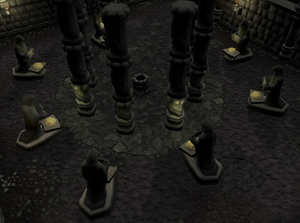
Drakan's forces crossed the River Salve through Silvarea in roughly 1100 and were immediately discovered by settlers north-east of Avarrocka. The Avarrockian military immediately responded en masse, beginning a complicated tactical battle revolving around Silvarea. For nearly 100 years, the two sides engaged each other in the mountain pass, each gaining and losing ground at an extremely slow pace. Thousands were killed on both sides, although those slain by Drakan's army are said to have died some type of particularly slow, lingering death.
As the war progressed, the Avarrockian army proved insufficient in fending off the campaign. Thousands of adults and children, many lacking any military experience, were called upon from small agricultural communities throughout Misthalin to serve. Regardless, Drakan ultimately was winning the battle through not only tactics but sheer force, his racially diverse military virtually bottomless in number. Much of House Drakan itself was present on the front lines of the war, prompting Drakan to betray his brother, Count Draynor, and leave him trapped in Misthalin. Whether or not Drakan himself was present at the site of the campaign remains unknown.
It was not until roughly 1200 that Misthalin was finally able to launch an effective defensive against Drakan. Seven Priestly Warriors: Ivandis Seergaze, Iriandul Caistlyn, Sarl Dunegun, Derygull Templeton, Erysail the Pious, Friar Twiblick, and Essiandar Gar emerged from various small Misthalanian settlements and led Misthalin's military. Drakan's forces were pushed back to the Salve in less than a year, prompting the priests to cast a joint spell of Saradomin's power upon the Salve. The spell created a powerful holy barrier within the river, prompting death in Drakan's followers should they touch it. Six of the seven priests were killed in the final sweep of Drakan's forces, leaving only Seergaze to lead an unsuccessful final campaign alongside soldiers such as Keorgius Feryis into Morytania. The Paterdomus Saradominist temple was built over the Salve's point of origin as a means of monitoring the border. The blessing of the Salve would mark the beginning of a new period of heavy isolation for Morytania and Drakan, who grew increasingly bitter in the aftermath of the event.
Mining Operations
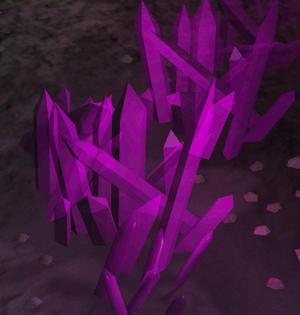
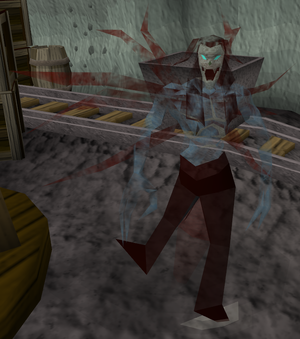
At an unknown point after the Misthalin - Morytania War, Drakan commissioned the excavation of an underground mine in south-western Morytania, near the mouth of the River Salve and impassable cliffs of the eastern Kharidian Desert. It was dubbed the Mort Ridge Mine. After assessing that the mine was rich enough to justify extraction, Drakan sent massive numbers of enslaved humans from ghettos and camps such as Meiyerditch to work the mine. Underground ruins adjacent to the mine were theorised by Tarn Razorlor as having potentially been built by Drakan years before, although this remains unconfirmed.
The Morytanian mining network would become one of the largest in the world at the time, rivalling those of isolated subterranean cities such as Keldagrim and Dorgesh-Kaan. Huge amounts of ore, ranging from iron and coal to mithril and adamantite were extracted and brought to the Sanguinesti Region for processing. Whether or not the metalworking plant now present beneath Meiyerditch was in existence at the time is unknown. The majority of those laboring in the mines were humans or criminals, meaning that conditions in the mine were so bad that thousands were worked to death and suffered from mining-related diseases. A select few vampyre overseers were sent to manage the miners.
Years into the operation, Drakan abruptly ordered the closing of the mine and the violent slaughter of its entire workforce. Miners and overseers alike were brutally killed through strategic collapsing of the mine's outer entrances and direct violence. Drakan imprisoned close follower Treus Dayth in the mine to protect it, binding his soul to the area and leaving him eternally trapped. Furthermore, the violent death of the miners left their aggressive spirits bound to the mine, making it one of the most haunted sites in the world. The reason for the mine's sudden destruction was never released to the Morytanian public; secretly a huge deposit of foreign crystals had been discovered in the lowest depths of the mine, where workers had been tunnelling deeper in search of new veins. These salve crystals had been created by blessed water from the Salve seeping into the mines and leaving deposits that could potentially be used to kill Drakan's followers. The mine would remain abandoned for more than a century.
Misthalanian Settlers
In 1777 of the Fourth Age, Morytania saw a massive immigration of human settlers from modern-day Misthalin and Asgarnia. The last contact with Morytania had been more than 500 years ago, during the Misthalin - Morytania War, and as a result Morytania's fearsome reputation was dismissed by many as exaggerated. The settlers travelled through Paterdomus and rapidly established numerous settlements, the largest of which were Port Phasmatys, Mort'ton, and the Lordship of the North Coast.
Drakan's gradual withdrawal from the northern reaches of Morytania and focus on affairs in the Sanguinesti Region meant that settlers found a seemingly uninhabited region with no obvious threats. Beyond the Salve, human settlements were constantly struggling with races such as goblins, hobgoblins, and giants, making life extremely uncertain for those in Avarrocka and other small villages. Northern Morytania rapidly developed, making it larger and safer than most of Misthalin and Asgarnia at the time.
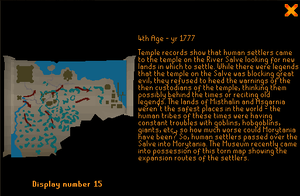
Port Phasmatys rapidly became a trading hub and cultural melting pot, trading with the Eastern Lands and tropical islands to the south-east and rivalling the ports of Menaphos and Port Lina in size. Mort'ton also became a successful, but more land-locked, trading post. The Lordship of the North Coast was perhaps the largest of the settlements, building itself around the recently abandoned castle of Charos. Charos, a close human advisor of Drakan, had, only years before, attempted to use his mind-bending powers to control his master, leading to his death or imprisonment. The Lordship extended far south into the Haunted Woods.
Drakan's focus on Sanguinesti meant that the human settlers, despite introducing a level of commerce not seen in the region since Hallowvale's peak, were not noticed for more than 200 years. Drakan's fearsome reputation diminished as the humans of Morytania benefited from a peaceful lifestyle and word spread beyond the Salve that conditions in Morytania were at times better than those outside the region.
Fifth Age
Reclaiming Morytania
In the Year 23 of the Fifth Age, Drakan became aware of the human development that was rapidly spreading across Morytania. Temporarily turning his attention from Sanguinesti, Drakan sent groups of vampyres into these settlements, each instructed to take blood tithes from them. Settlers were caught completely off-guard to find that the vampyric race existed in such numbers, eventually leaving them no choice but to comply with the tithes. Smaller settlements that refused these were presumably destroyed completely and their residents killed or imprisoned in Sanguinesti.
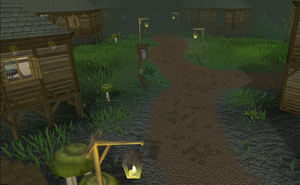
Gradually every settlement in Morytania was forced to accommodate the tax. The Lordship of the North Coast, situated so close to Paterdomus, gradually dissipated as inhabitants were killed, taken, or fled beyond the Salve, where the Fremennik Moon Clan's discovery of runestones had allowed the central human kingdoms to grow extremely prosperous. Lord Rologray, master of the Lordship, firmly resisted Drakan's demands of tithing and fortified Castle Fenkenstrain in defence. Meanwhile, Port Phasmatys's trade with the Eastern Lands and islands such as Harmony, Mos Le'Harmless, and others was compromised severely by the tithing. The city's residents were forced to enlist the assistance of Necrovarus <ref>http://services.runescape.com/m=rswiki/en/Port_Phasmatys "Port Phasmatys (Members)," RuneScape Knowledge Base</ref> an Eastern mage who used a large deposit of ectoplasm to create a barrier locking Drakan out but also trapping the souls of those inside. Mort'ton complied with the tithe, but when the Sanguinesti Affliction overtook the village, by chance or design, the blood of its people was made poisonous to the vampyres. Efforts by pharmacists such as Herbi Flax and Liornish Stemplehair to cure the affliction came too late, and tithing of the settlement was mostly abandoned.
Also in 23, a tribe of werewolf nomads created the Canifis settlement near the eastern border of the North Coast with Drakan's permission and promise to provide tithes. The town's close proximity to Paterdomus would have made capturing humans for the tithe relatively simple. Although the process of reclaiming Morytania was gradual, by the recent Fifth Age nearly all of Morytania is controlled by Drakan. Furthermore, the swamp-like conditions that had dominated much of the region since Drakan's establishment crept further north, reshaping the north coast. Only Burgh de Rott and the undead citizens of Port Phasmatys escaped his direct control, albeit the conditions in both have since been extremely poor.
Sanguinesti Oppression
In roughly the 150s or 160s, Drakan imposed further laws and demands on the people of Meiyerditch, whose population had grown as result of tithing outside the city. Drakan oversaw the complete shutdown of the ghetto's human-run market, destroying what few businesses existed in the area. The Sanguinesti black market would manage to escape this, however, as residents such as Trader Sven and Old Man Ral avoided notice. Exactly what sparked this action by Drakan remains unknown, although it may have been related to the actions of the Myreque.
Drakan, shortly before or after this, also saw the opening of the daeyalt mines beneath the city. Using slave labour from those throughout the region, Drakan saw the digging of a deep mining network and the construction of a huge underground processing plant for the ore, echoing his behaviour in the western mines centuries before. What the daeyalt ore is being used for remains a closely guarded secret, although the Imcando Dwarf Thurgo believes the ore to possess magical properties.
The most infamous of Drakan's developments during this time was the Meiyerditch blood lab. The lab was designed by Drakan and his scientists in an effort to find new ways of extracting blood tithes, which the House hoped to be obtained more rapidly through these ways. Claiming the lab was being used to develop methods of improving living conditions in the ghetto, Drakan ordered the capture or recruitment of many resident humans to work in the lab. Those humans physically and mentally fit for more technical labour assisted the vampyres in the study of Haemalchemy, a little-known branch of science they did not fully understand. Those unfit for lab work were taken to a secret cavern adjacent to the lab, where human experimentation was overseen by haemalchemists. The remains of work performed in the caves has recently been discovered, and includes a variety of cages, restraining devices, and precision surgical tools. Several disfigured human corpses are still present. Medical supplies, such as anaesthetic, medication, and bandages, are not present and so presumably were not used to ease the suffering of test subjects.
Several years ago, the blood labs were abruptly shut down and the majority of its workers presumably slain on Drakan's orders. Vanescula Drakan later explained to an adventurer working with the Myreque that lab workers discovered through their extensive research of Haemalchemy that Vampyres can survive without the consumption of blood. That discovery itself could bring down the entire Vampyre society. However, word of the lab's existence escaped through workers such as Mauritys Guile, father of House servant Sarius Guile.
The War of 164
In 164, a werewolf of Canifis named Gar'rth managed to cross the River Salves holy barrier, due to him still being an innocent and his soul not being controlled by Zamorak, in an effort to escape his race's violent lifestyle. Gar'rth's escape was immediately noted by villagers, prompting Lord Drakan's direct intervention. Because of the werewolf race's extremely low birth rate, Drakan sent Gar'rth's acclaimed uncle Jerrod to bring him back to Morytania. Using a complicated sacrificial ritual, Drakan managed to get Jerrod across the river.
Jerrod crossed Misthalin in a months-long process before succumbing to hunger in Asgarnia. After feeding on nearly a dozen Asgarnians, including entire gypsy and Humans Against Monsters caravans, Jerrod found Gar'rth living with Taverley residents Ebenezer and Castimir shortly before they travelled to Falador. Jerrod allied himself with Kinshra Lord Sulla, who was staging the War of 164 against Asgarnia, in order to capture Gar'rth as a prisoner of war. Although Drakan, through a vision in Falador, originally instructed Jerrod to avoid killing, this policy evidently changed as the war developed.
Jerrod personally aided Sulla in the Battle of the Monastery and Siege of Falador, but ultimately the united Dwarven Realm and Asgarnians were successful. After having his hands severed by long-time enemy Kara-Meir, Sulla was left to die in the northern Asgarnian woodlands. Jerrod intervened, rescuing Sulla from his own men and taking him to Morytania as part of a yet-unknown plan developed by Drakan himself. Gar'rth managed to evade capture and became an accepted resident of Falador.
The Myreque and the Sanguinesti Liberation War
Main Article: Myreque quest series, Sanguinesti Liberation War.
In the recent Fifth Age, a rebel group known as the Myreque emerged in the Sanguinesti Region. Although they are not the first to challenge Drakan from within, they have proven to be the most successful. Under the leadership of commanders such as Safalaan Hallow, Calsidiu, and Veliaf Hurtz, the Myreque established a complex resistance effort throughout Morytania.
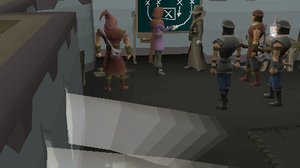
In 169, Drakan sent Vyrewatch member Vanstrom Klause to Canifis, from which he tracked an adventurer to the Myre Order's base beneath Mort Myre. Klause was narrowly forced to retreat, leaving the Myreque no choice but to relocate. With the help of the adventurer Vanstrom manipulated, the Order found safety in Burgh de Rott, where Sanguinesti-escapee Elisabeta had established a hideout for refugees. After fending off tither Gadderanks, the adventurer made contact with the Sanguinesti Order in Meiyerditch and began to directly aid the Myreque plot the downfall of Drakan. Recruiting the assistance of King Roald Remanis III of Misthalin, the adventurer helped to establish a Mercenary protocol that brought humans through the recently-captured Paterdomus to aid the Myreque. Furthermore, the threat of both Morytanian and Wilderness-based invasion prompted the construction of a Beacon Network spanning from Silvarea to the Frozen Waste Plateau,<ref>http://services.runescape.com/m=rswiki/en/The_Beacon_Network "Firemaking - The Beacon Network," RuneScape Knowledge Base</ref> indirectly involving Troll Country, Burthorpe, the barbarians of Misthalin, and the Asgarnian goblin tribes in the conflict. Meanwhile, werewolves have reportedly attacked settlers in Silvarea, evidently having found a way through or around the Salve.
The adventurer also helped the Myreque to map Castle Drakan in an evident preparation for open attack. They helped to find the vampyre race's weakness with the help of Flaygian Screwte and also helped to re-discover the blood altar. The same adventurer helped discover a method of slaying the vyrewatch through the Ivandis flail, which is so unpredictable the mind-reading abilities of the vyrewatch are nullified. An Anti-Edicts Morytanian Splinter Group group have also become active near the borders of Morytania. The Myreque are currently engaged in constant skirmishes with Drakan's forces throughout Morytania, while the Sanguinesti Liberation War continues to escalate in size.
In 169, Lowerniel becomes more and more obsessed with some rock of unknown origin. Due to this, Lowerniel's sister Vanescula betrays him and helps the Myreque infiltrate the Sanguinesti capital of Darkmeyer. During these events, both Ranis Drakan and Vanstrom Klause are eliminated, making Lowerniel and his sister the only Drakans left.
Family
Drakan's family encompasses the whole of House Drakan. Since establishing Morytania, Drakan has made his family name an inherent title to rulership of the nation, spawning at times a limited version of feudalism. Given the size of House Drakan, Drakan seems to have, or has had, a sizable direct family, further supporting the idea that he came to Gielinor with the rest of his race. However, what exactly entails a blood relationship between vampyres might be more complicated than for other races. Only a handful of Drakan's relatives have been named, although many more likely exist.
Drakan's only known siblings are Count Victor Draynor Drakan, Ranis Drakan, and Vanescula Drakan. Count Draynor enjoyed relative prosperity in Morytania until the Misthalin-Morytania War. During a skirmish in Silvarea, Draynor was separated from the main body of the Morytanian military and was denied re-entry by Lowerniel Drakan, leaving him no choice but to hide with his aid, Ruantun, in Misthalin. Drakan allegedly cast Draynor out "for his cowardice," but further details have never surfaced<ref>http://services.runescape.com/m=rswiki/en/Postbag_19 "Postbag from the Hedge 19," Letter to Lord Drakan.</ref>
In The Branches of Darkmeyer quest, Ranis is killed by his sister Vanescula, leaving Lowerniel and Vanescula as the only remaining Drakan siblings by the end of the quest.
In the Return to Canifis novel, it is revealed that vampirism is never passed on through breeding. Thus, the members of Lord Drakan's house were most likely converted sometime after his family entered Gielinor.
Another prominent member of the house of Drakan, introduced (and thus far only mentioned) in Return to Canifis, is The Black Prince, a vampyre lord, once human and true heir to the throne of Misthalin. He seems to have some form of rivalry with Vanescula Drakan.
Other, more distant members of Drakan's family include Malak, Dessous, and likely Solomon Lamescus and Vanstrom Klause. Their exact relationship remains unknown.
Trivia
- Lord Drakan, like most vampires depicted in modern culture, displays many similarities to the fictional vampire Count Dracula, the antagonist in the 1897 gothic horror novel Dracula. Apart from their similar behaviour and physical traits, their names' beginning syllables, "Drak" and "Drac", are phonetically identical.
- According to the Cryptic Clue Fest IV of Diamond Jubilee, Drakan has hidden himself from public view due to him enjoying Twilight and being unable to face another since. This was only a mere joke, however.
| Preceded by | Title | Succeeded by |
|---|---|---|
| King Ascertes/Queen Efaritay | Ruler of Southern Morytania/The Hallowland | Incumbent |